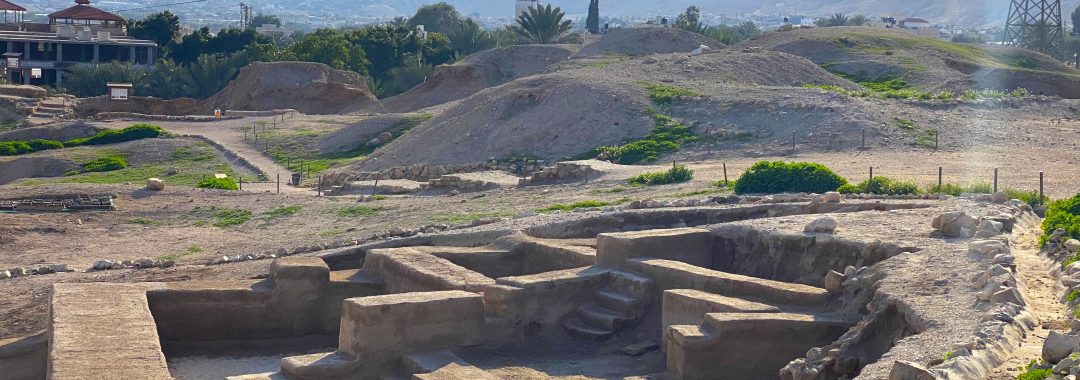National and international experts and partners gathered in Jericho for a two-day symposium on the conservation and management of Tell es-Sultan / Ancient Jericho, as part of the Tell-es Sultan Conservation Project.
Participants, including national and international experts and specialists gathered in Jericho this week for a two-day international symposium on the conservation and management of the site of Tell es-Sultan/ Ancient Jericho.
The symposium is part of the ongoing project to conserve and manage the site which is being implemented jointly between UNESCO, the Ministry of Tourism and Antiquities (MoTA) and Roma La Sapienza University, with funding from Italy through the Italian Agency for Development Cooperation (AICS Jerusalem Office).
This international scientific symposium is the first activity of the Tell es-Sultan Conservation Project which aims to preserve the ancient archaeological remains of the site and highlight its unique values, while also ensuring its potential as a visitor attraction is realized to benefit the local community and economy.
The symposium discussed strategies and methodologies for the preservation, management, and interpretation of archaeological sites, and how they might be implemented on the site of Tell es-Sultan, which is one of the oldest inhabited places in the world dating back to approximately 10,000 years. The site has also been nominated by Palestine for inscription on the UNESCO World Heritage list.
Over the course of the two days, participants in the symposium discussed and explored the status of the site and examined ways forward for its effective conservation and management, based on current best practices and international expertise and experience in the conservation, management, and promotion of cultural heritage. Site visits were also conducted to Tell es-Sultan and to the nearby Hisham’s Palace.
Speaking at the opening, Ms. Noha Bawazir, Head of Office and UNESCO Representative to Palestine, recognizing the great value of the multistakeholder partnership established with MoTA, La Sapienza University, thanks to the strategic financial support from Italy, stated that “investing in the proper conservation, management and interpretation of this unique archaeological site will contribute to its significant revival. It will also enrich people’s knowledge about important cultural periods and history, that will help enhance belonging and pride.”
The Minister of Tourism and Antiquities, H.E Rula Maayah, stressed the exceptional significance of the archaeological site of Tell es-Sultan, nominated for inscription on the World Heritage List. Maayah said that “since Palestine’s accession to UNESCO, several Palestinian sites have been inscribed on the prestigious World Heritage List. Now we are working to add Tell es-Sultan to this list. This inscription would have multiple benefits including the promotion of both internal and external tourism and the generation of livelihoods.”
Adding to this, Consul General of Italy in Jerusalem, H.E. Giuseppe Fedele, emphasized the importance of the event explaining that “this project is another step forward in the protection, conservation, and valorization of Palestinian cultural heritage. It has been made possible through the work of Italian archaeological missions which, over the years, have made their expertise available to Palestinian professionals and institutions, in particular the Ministry of Tourism and Antiquities”.
Director of the Italian Agency for Development Cooperation Jerusalem, Mr. Guglielmo Giordano, continued: “This project is a unique opportunity to work with local communities to create jobs through urban development initiatives and the promotion of local businesses. It aims to fulfil Tell es-Sultan’s potential as a vital site for the history of humanity.” He expressed his confidence “that these improvements will attract an ever-increasing number of tourists and strengthen the link between cultural and economic development, a link in which the Italian Agency for Development Cooperation has always believed in.”
Professor Lorenzo Nigro from La Sapienza University of Rome added: “In April 1997 Palestinian archaeologists, restorers, and professionals began to work in Tell es-Sultan with Italian colleagues from Rome La Sapienza University, developing a model of cooperation based on the assumption of joint responsibility for an activity aimed at safeguarding and enhancing the scientific, cultural, and touristic value of the archaeological site. The work in Tell es-Sultan extended to the valorization of the site through its restoration and rehabilitation, and the training of personnel dedicated to welcoming visitors and sharing this outstanding cultural heritage.”
In his remarks, Permanent Delegate of Palestine to UNESCO, H.E Mounir Anastas, said: “The nomination dossier for the Tell es-Sultan site to the UNESCO World Heritage List was the first submitted via the normal procedure and not on an emergency basis, as the three currently inscribed sites were.” He added: “The interest shown by Palestinian partners and the local community in the city of Jericho is proof of their commitment to preserve and manage Tell es-Sultan not only as a Palestinian cultural heritage site, but as World Heritage bearing exceptional values for all humanity.”
Mayor of Jericho, Mr. Abdul Karim Sidr, stated “the Municipality of Jericho has provided what is required at its level to prepare the nomination dossier for the site of Tell es-Sultan for inscription on the World Heritage List and is ready to provide additional assistance should it be necessary. The Municipality has already made decisions to remove some obstacles facing the proper conservation and management of the site and has started implementing them.”

